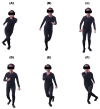The Effect of Skating Exercises as High-Intensity Interval Training on Elderly Stroke Patients
- PMID: 40722269
- PMCID: PMC12293109
- DOI: 10.3390/brainsci15070676
The Effect of Skating Exercises as High-Intensity Interval Training on Elderly Stroke Patients
Abstract
Background/objectives: High-intensity interval training (HIIT) can optimize recovery by complementing the low cardiovascular fitness intensities typically achieved in stroke rehabilitation programs. Skating exercise is an HIIT workout developed based on ice skating movements, and we investigated the effects of this exercise on the cardiorespiratory fitness of elderly patients with minor stroke.
Methods: Participants aged 65 or older with a National Institutes of Health Stroke Scale score of 3 or lower were recruited. This study was designed as a randomized controlled trial, in which the intervention group engaged in skating exercises following HIIT, while the control group underwent moderate-intensity continuous training (MICT). Both groups of participants performed either HIIT or MICT for 20 min per day, four times a week, over three months.
Results: A total of 34 elderly patients with minor stroke were recruited, with an average age of 70.7 years. For three months, no fall-down injuries or adverse cardiovascular or cerebrovascular events were reported among patients undergoing HIIT or MICT. Both the intervention and control groups showed significant increases in the measures of aerobic capacity after the intervention. However, the patients in the intervention group exhibited significantly greater improvements in peak oxygen uptake, ventilatory threshold, and peak MET (p = 0.005, p = 0.002, and p = 0.024, respectively). Additionally, the Berg Balance Scale (BBS) scores and the skeletal muscle mass index showed significantly greater enhancements in the intervention group compared to the control group (p = 0.032 and p = 0.032).
Conclusions: In conclusion, skating exercise could be a safe and effective HIIT protocol for elderly people who have experienced a minor stroke.
Keywords: cardiorespiratory fitness; exercise; high-intensity interval training; muscles; postural balance; rehabilitation; skating; stroke.
Conflict of interest statement
The authors declare no conflicts of interest.
Figures



Similar articles
-
Physical exercise training interventions for children and young adults during and after treatment for childhood cancer.Cochrane Database Syst Rev. 2016 Mar 31;3(3):CD008796. doi: 10.1002/14651858.CD008796.pub3. Cochrane Database Syst Rev. 2016. PMID: 27030386 Free PMC article.
-
The impact of high-intensity interval training versus moderate-intensity continuous training on vascular function: a systematic review and meta-analysis.Sports Med. 2015 May;45(5):679-92. doi: 10.1007/s40279-015-0321-z. Sports Med. 2015. PMID: 25771785
-
Physical exercise training interventions for children and young adults during and after treatment for childhood cancer.Cochrane Database Syst Rev. 2013 Apr 30;(4):CD008796. doi: 10.1002/14651858.CD008796.pub2. Cochrane Database Syst Rev. 2013. Update in: Cochrane Database Syst Rev. 2016 Mar 31;3:CD008796. doi: 10.1002/14651858.CD008796.pub3. PMID: 23633361 Updated.
-
Falls prevention interventions for community-dwelling older adults: systematic review and meta-analysis of benefits, harms, and patient values and preferences.Syst Rev. 2024 Nov 26;13(1):289. doi: 10.1186/s13643-024-02681-3. Syst Rev. 2024. PMID: 39593159 Free PMC article.
-
High-intensity interval training with robot-assisted gait therapy vs. treadmill gait therapy in chronic stroke: a randomized controlled trial.J Neuroeng Rehabil. 2025 Aug 2;22(1):173. doi: 10.1186/s12984-025-01674-0. J Neuroeng Rehabil. 2025. PMID: 40753404 Free PMC article. Clinical Trial.
References
-
- von Weitzel-Mudersbach P., Andersen G., Hundborg H.H., Johnsen S.P. Transient ischemic attack and minor stroke are the most common manifestations of acute cerebrovascular disease: A prospective, population-based study-the Aarhus TIA study. Neuroepidemiology. 2013;40:50–55. doi: 10.1159/000341696. - DOI - PubMed
Grants and funding
LinkOut - more resources
Full Text Sources
Miscellaneous

